Picking the perfect white paint for your home seems simple at first, right? But honestly, it’s one of the trickiest color choices you’ll ever make.
Remember to repin your favorite images!
There are just so many shades, each with its own undertones, and lighting completely changes the look. Finding your ideal white can get overwhelming fast.
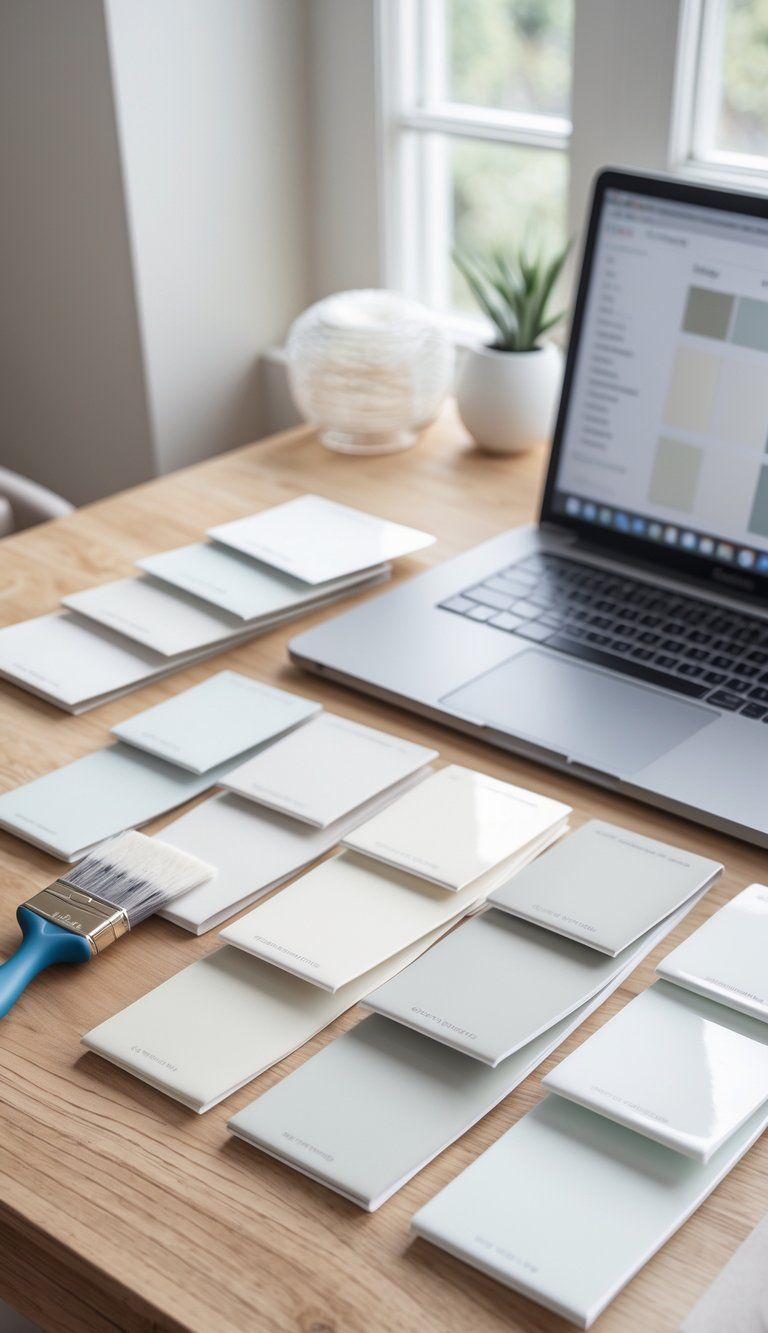
The right white paint can totally transform a room. It creates visual simplicity but still adds depth and warmth.
You’re not just picking any white off the shelf. You have to think about undertones, lighting, and how your furniture and decor will play with the color.
A white that looks crisp in the store might turn yellowish or even cold in your living room.
You’ll want to look at several factors, like how much natural light your room gets, which way your windows face, and what kind of vibe you’re after.
Here, I’ll walk you through a step-by-step process to help you actually narrow down the perfect white paint—without wasting money or ending up with a color you hate.
Understanding White Paint
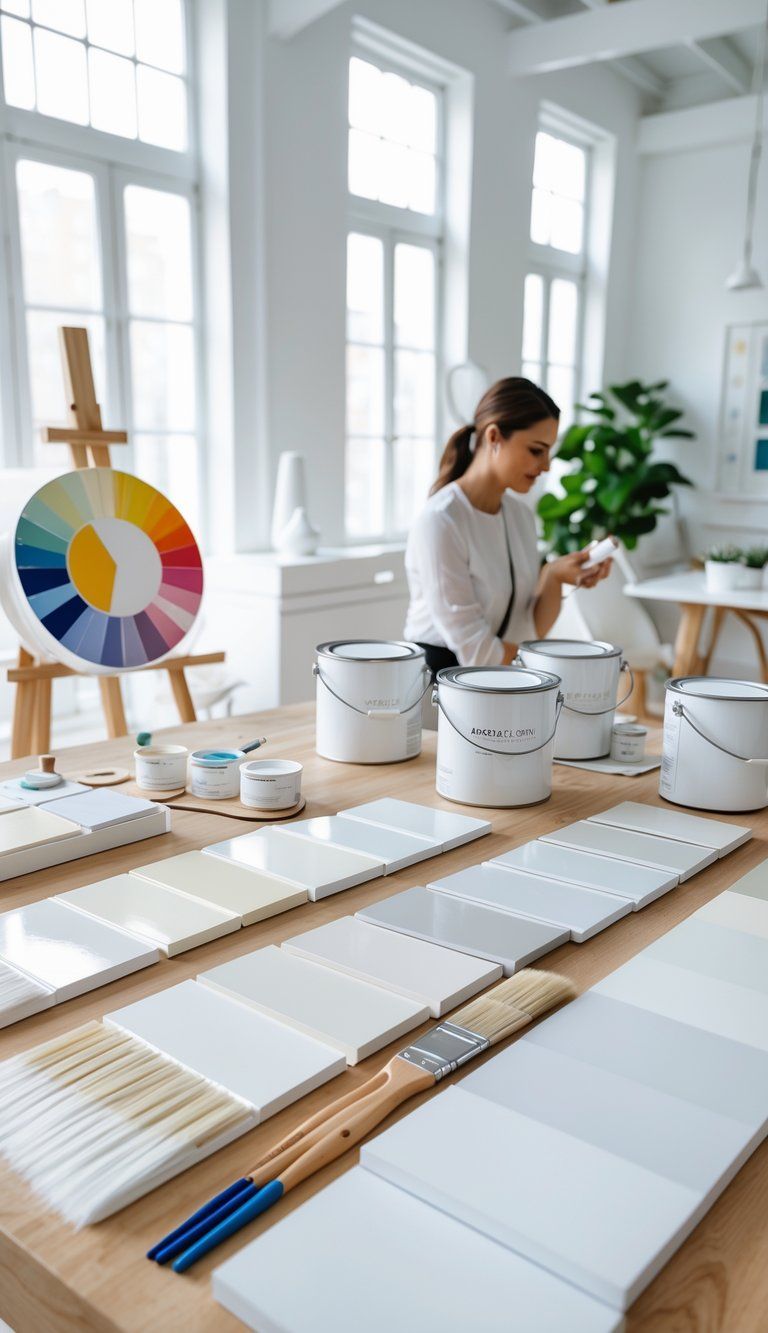
White paint sounds straightforward, but there’s a lot to it. You’ll find quite a few types, popular colors, and subtle differences between shades.
When you get familiar with these, picking the right white for your home gets a whole lot easier.
Types of White Paint
White paints usually fall into a few main categories, all based on their undertones.
Pure whites barely have any undertones at all. They look sharp and modern, especially in minimalist spaces.
Warm whites have undertones of yellow, red, or brown. They make rooms feel cozy and welcoming.
Cool whites carry blue, purple, or green undertones. These give a crisp, fresh vibe and work well in rooms with northern light or a contemporary feel.
Off-whites aren’t truly white—they’re creamy or have noticeable undertones. You’ll find these a bit more forgiving under different lighting.
Performance whites are specialty formulas: high-hiding, washable, or mold-resistant paints for places like bathrooms and kitchens.
Popular White Paint Colors
People love Benjamin Moore’s “White Dove” for its soft, warm undertones and versatility. It just works almost anywhere.
Sherwin Williams “Pure White” delivers a clean look, but it doesn’t feel too harsh or clinical.
Behr’s “Polar Bear” gives you a true white that feels right at home in modern interiors.
If you want something a bit warmer, Benjamin Moore’s “Simply White” adds a touch of warmth without turning yellow.
Sherwin Williams “Snowbound” brings in subtle gray undertones, perfect for cooler spaces.
Always test these colors in your own space and check them at different times of day.
Shades of White
Bright whites like Benjamin Moore’s “Chantilly Lace” reflect loads of light and give you that crisp, clean look. They shine in rooms with lots of sunlight but might feel too stark in darker corners.
Soft whites such as Sherwin Williams’ “Alabaster” have gentle undertones. They’re more forgiving and add warmth without looking beige.
Creamy whites like Behr’s “Swiss Coffee” have stronger yellow undertones and feel especially inviting. These can really warm up a north-facing room.
The best move? Test sample patches right on your walls. Try at least a 2’x2′ area and check it out throughout the day.
Decoding Undertones in White Paint
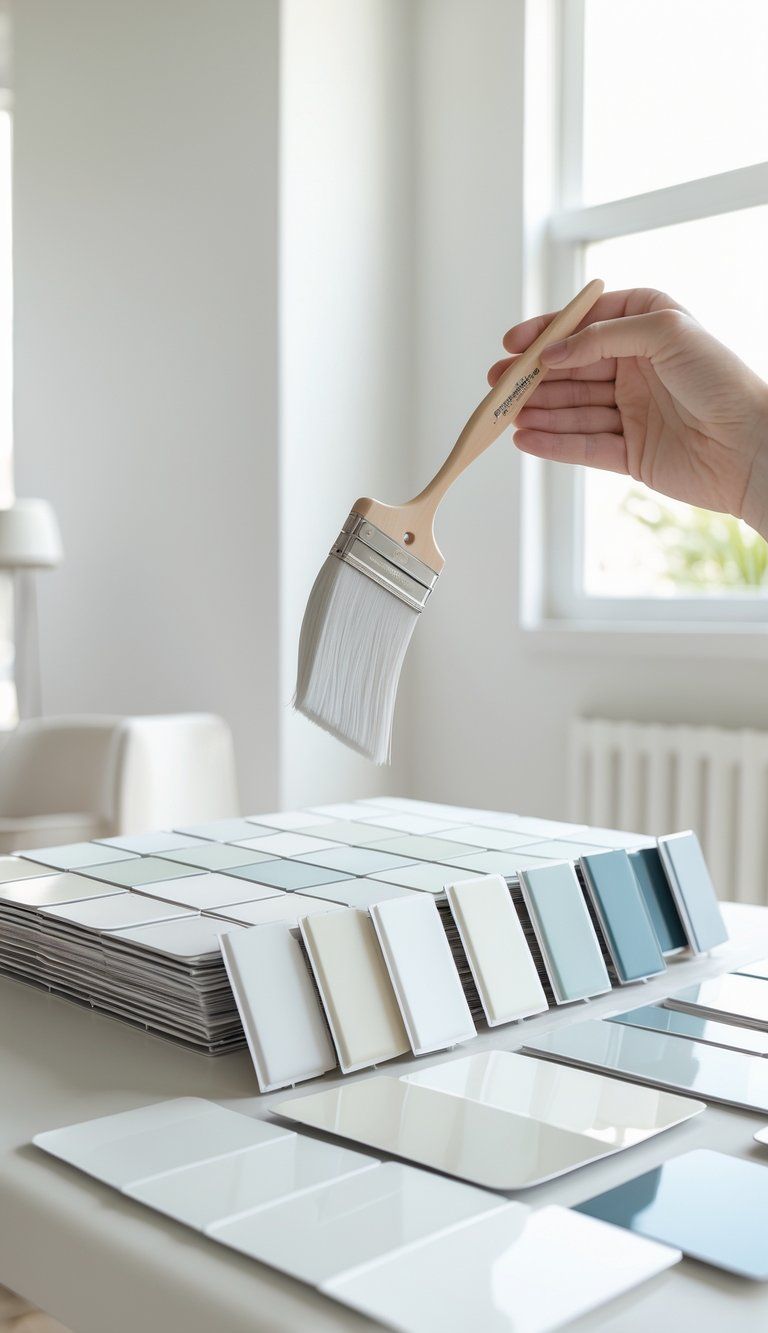
White paint isn’t just white. Each shade hides subtle hints of color that can totally change the mood of a room.
If you want to pick the right white, you really need to understand these undertones.
Warm Undertones
Warm whites have a bit of yellow, red, or orange mixed in. They make spaces feel soft and inviting.
Sherwin Williams Westhighland White works well for living rooms, giving off a cozy vibe but still keeping things bright.
Other warm whites you might like:
- Benjamin Moore Swiss Coffee: Creamy with gentle yellow undertones
- Behr Polar Bear: Soft and warm, great for rooms facing north
- Sherwin Williams Alabaster: Versatile and warm, but not overly yellow
Warm whites really shine in living rooms, bedrooms, and dining areas. They also help balance out cool-toned decor.
Just keep in mind that in natural light, especially south-facing rooms, warm whites might look a bit more yellow.
Cool Undertones
Cool whites bring in blue, green, or purple hints. They create a crisp, clean look that feels fresh—perfect for bathrooms and kitchens.
Here are some popular cool whites:
- Benjamin Moore Chantilly Lace: Clean with almost no undertones
- Sherwin Williams Extra White: Bright with a touch of blue
- Behr Ultra Pure White: Super white, definitely on the cool side
Cool whites look their best in north-facing rooms. If you use warm lighting, they can balance out that yellowish glow from bulbs.
But, if you’re not careful, cool whites can feel a little cold or even clinical. Wood accents or textiles help warm things up.
Neutral Whites
Neutral whites stay balanced. They don’t lean too warm or too cool, so they’re super adaptable.
Some great neutral whites:
- Benjamin Moore Simply White: Works almost anywhere
- Sherwin Williams Pure White: Not too warm, not too cool
- Farrow & Ball All White: Clean and simple, without strong undertones
If your home has an open floor plan or rooms with changing light, neutral whites are a safe bet.
They also let you mix and match warm and cool accents without clashing.
Unexpected Undertones
Sometimes, whites surprise you with odd undertones—pink, green, or even purple can sneak in.
Watch for these:
- Pink undertones: Pop up in whites with red-yellow bases, like Benjamin Moore White Dove
- Green undertones: Show up in grayer whites, like Sherwin Williams Snowbound
- Purple undertones: Lurk in cool whites like Benjamin Moore Decorator’s White
To spot these, hold your paint sample next to a sheet of pure white paper. The undertones usually jump out.
Test your paint at different times—morning, afternoon, evening—so you don’t get any nasty surprises after you paint the whole room.
The Impact of Lighting on White Paint
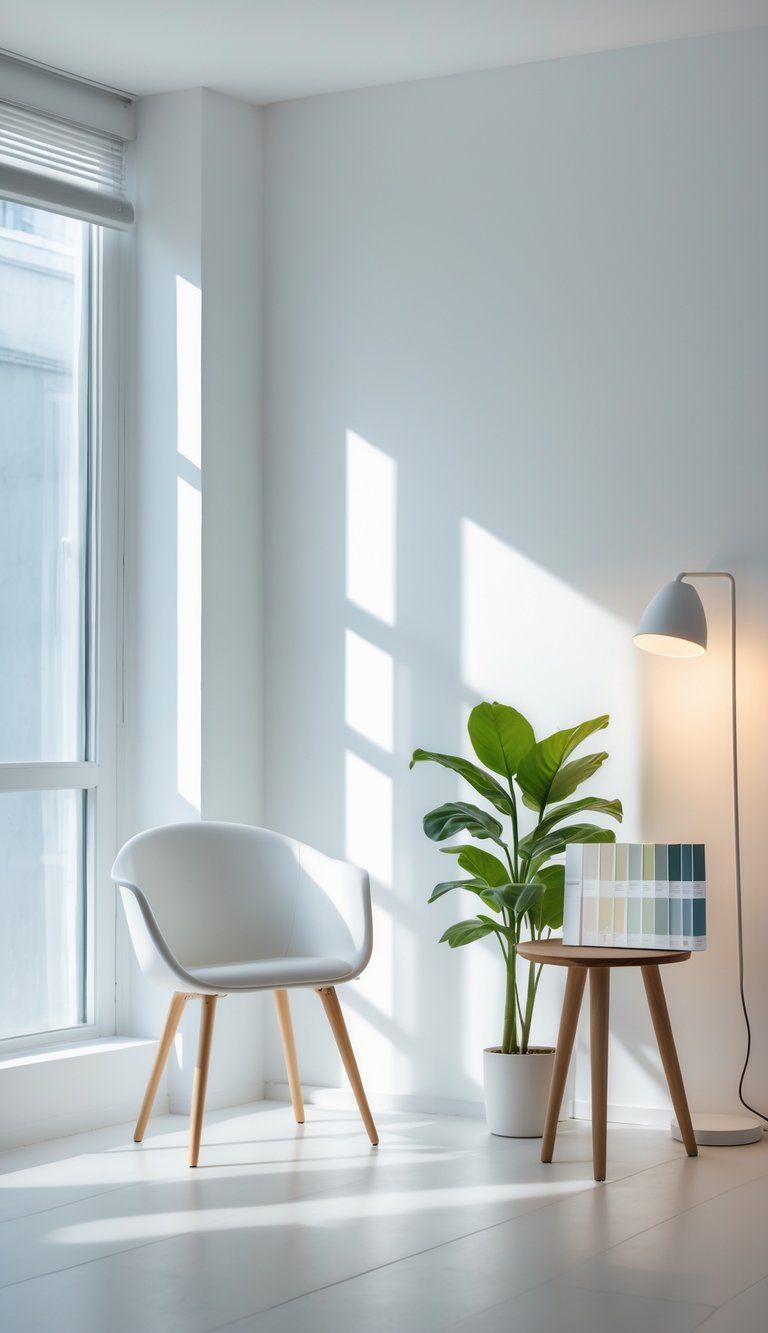
Lighting can completely change how white paint looks on your walls. A white that’s bright in the store might turn cream, gray, or even blue in your home, all depending on the light.
Natural Light
Natural light plays the biggest role. The direction your windows face really matters.
North-facing rooms get cooler, bluish light. Whites here can look gray or blue, so warmer whites help balance things out.
South-facing rooms soak up warm sunlight, which brings out yellow tones in white paint. Cooler whites can keep things feeling balanced.
East-facing rooms see bright, yellow light in the morning, then cooler light later on. Your walls will shift color throughout the day.
West-facing rooms get golden afternoon light, so whites here might look more yellow or cream as the day goes on.
Always test paint samples at different times to see how the color shifts.
Artificial Light
Lightbulbs change things up, sometimes even more than sunlight.
Incandescent bulbs throw off a warm, yellow glow. They make whites look creamier and warmer—sometimes too much.
LEDs come in a bunch of temperatures. Warm white LEDs (2700-3000K) feel cozy, like incandescents. Cool white LEDs (3500-4100K) feel brighter and more energetic. Daylight LEDs (5000-6500K) add a bluish tint, which can really cool down a room.
Fluorescent lights sometimes cast a weird green tint, making whites look flat or even a bit green.
Halogen bulbs give off crisp, white light and show off undertones pretty accurately.
Always check your paint under the actual artificial lighting you’ll use in the room.
Ambient Lighting
Ambient lighting is just the overall glow from all your light sources.
Brighter rooms make whites look cleaner and more vibrant. Dim rooms can make whites feel muted or gray.
If you layer your lighting—ceiling lights, lamps, accent lights—you’ll get a more balanced look on your white walls.
Light fixtures with shades or diffusers soften things up and spread light evenly. Clear glass fixtures make the light sharper and highlight wall texture.
Think about how your room’s lighting changes from day to night and how that’ll affect your white paint.
Lighting and Color Perception
White paint reflects whatever’s around it. This is called color reflection, or bounce light.
A bright red sofa could cast a pinkish hue on your white walls, especially in certain lighting.
Time of day changes things, too. Morning light is clearer and bluer, while evening light feels warmer and more golden. Your white paint will shift along with it.
Even the season matters. Winter light is cooler and angled, while summer light is stronger and more direct.
Ceiling color also affects your wall paint. White ceilings bounce light differently than colored ones.
Shadows play a big role, making the same paint look like different shades across a single wall.
Choosing the Perfect White Paint
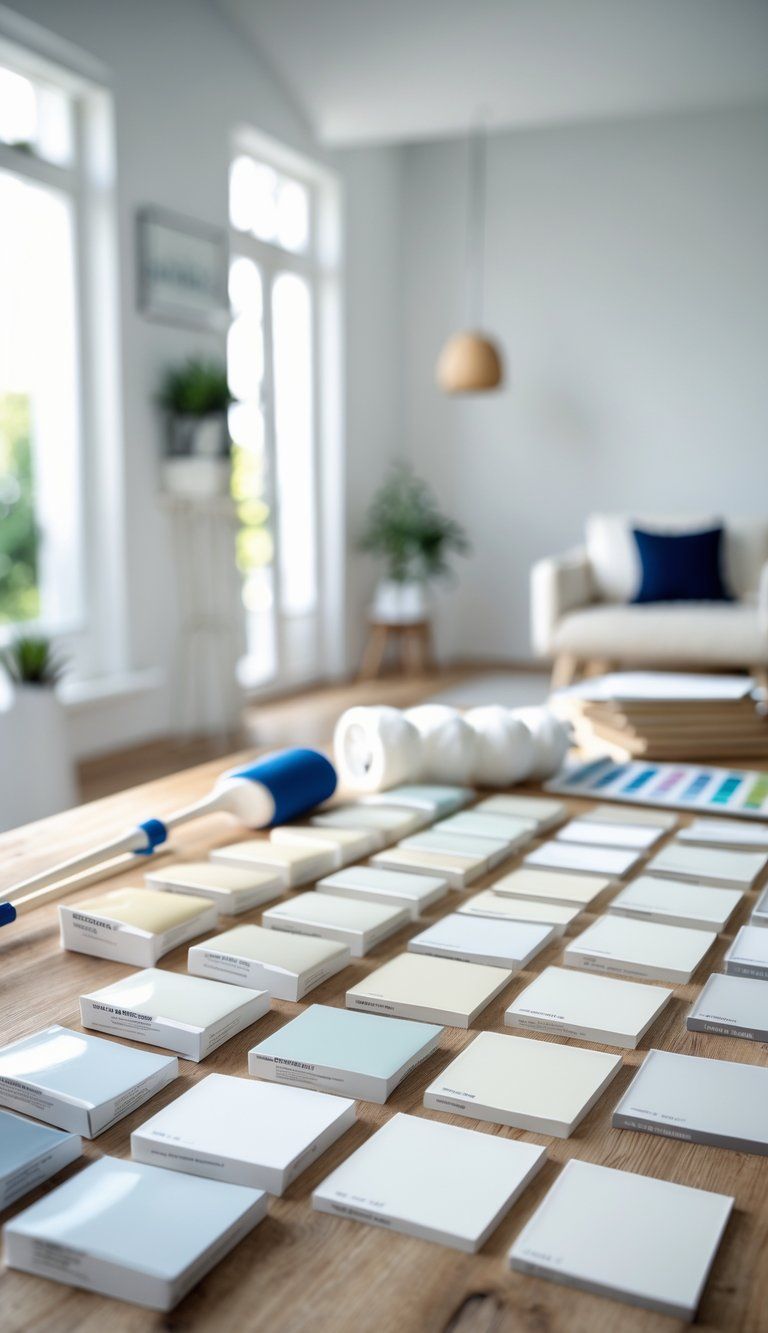
Picking the right white paint takes more thought than just grabbing a random can. The best white for you depends on your space, your style, and what you already have in the room.
Assessing Your Space
Start by checking out your room’s natural light. North-facing rooms get cooler light that can make whites look blue or gray. Warmer whites with yellow or cream undertones help here.
South-facing rooms get warm, yellowish light. True whites or slightly cooler whites can balance things out.
Room size makes a difference, too. Smaller rooms often feel bigger with brighter whites, while larger spaces can handle creamier or softer whites.
Ceiling height matters more than you’d think. Lower ceilings with bright whites make a room feel airier.
Take a few minutes to see how your space looks at different times of day. Light changes everything.
Considering Style and Mood
Your design style should steer your white paint choice. For modern or minimalist looks, crisp whites with little to no undertones usually work best.
Traditional homes often look better with warmer, creamier whites that feel cozy.
Think about the mood you want:
- Bright, energetic spaces: Go for clean whites with barely any undertones
- Calm, relaxing areas: Soft whites with a hint of gray work well
- Warm, inviting rooms: Whites with yellow or beige undertones are your friend
White paint can change a lot under different lights. Always test your picks under the actual lighting in your home—LED, fluorescent, incandescent, whatever you use.
Matching with Existing Décor
Let your furniture, flooring, and fixtures steer your white paint choice. If you’ve got dark wood furniture, you’ll probably love how it pairs with warmer whites. Modern pieces in cool tones? Crisp whites usually look best.
Start with your biggest fixed elements:
- Flooring: Warm-toned floors? Stick with warm whites.
- Kitchen cabinets: Choose whites that play nicely with your cabinet finish.
- Stone countertops: Notice any undertones in your marble or granite? Try to pull those out in your paint.
Don’t overlook your fabrics. Curtains, rugs, and upholstery all change how your wall color feels. Bring fabric swatches when you’re picking paint so everything works together.
Always test at least three or four white samples on your walls before deciding. Paint big swatches—two feet square is good—and watch them for a few days to see how they shift with the light.
Top White Paint Picks from Leading Brands
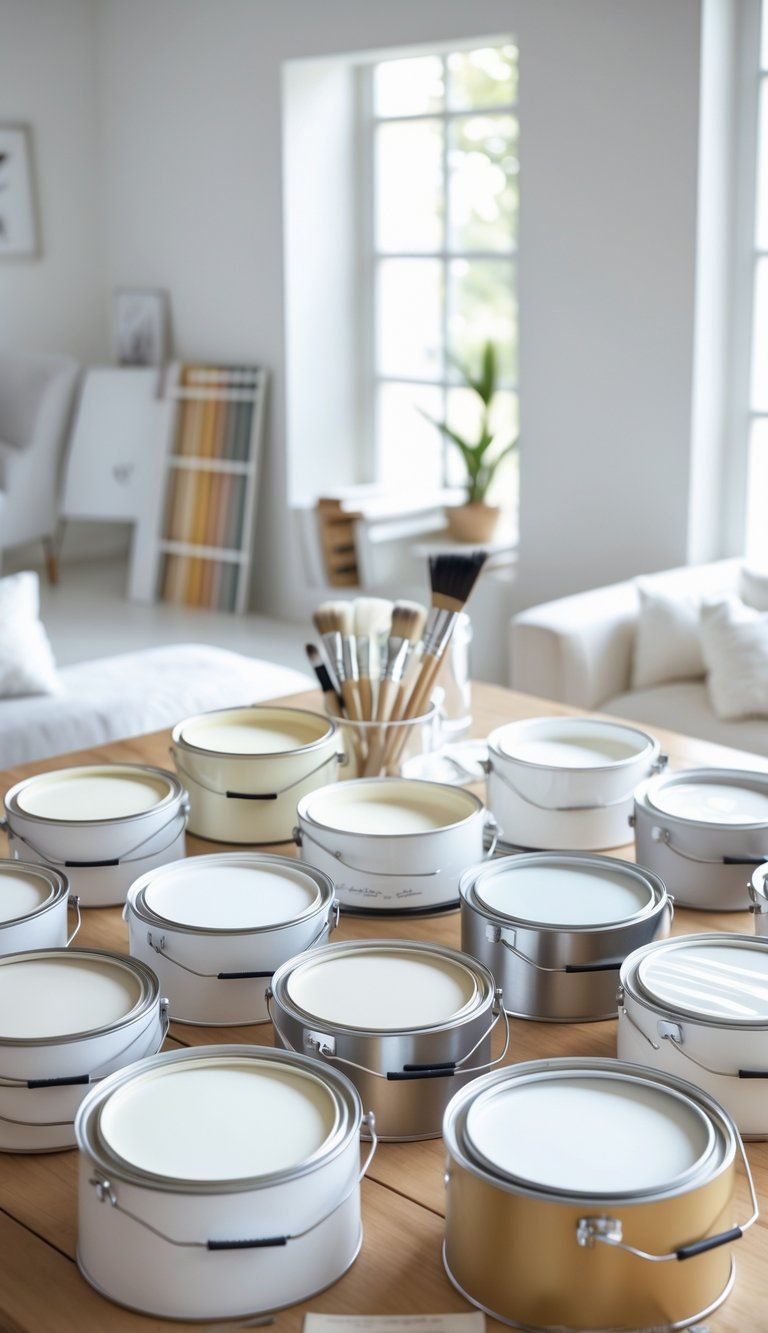
Designers keep coming back to certain white paints from top brands. Every brand has its own standout whites with undertones and qualities that shine in different rooms and lighting.
Benjamin Moore Favorites
White Dove really holds the crown for Benjamin Moore. It’s soft and warm, with gentle undertones that make living rooms and bedrooms feel inviting. It doesn’t come off too stark or too yellow—it’s just right.
Chantilly Lace gives you a crisp, clean white. Many designers call it Benjamin Moore’s brightest white. It’s perfect for modern spaces where you want that fresh, gallery vibe. Chantilly Lace barely has any undertones, so it’s a true white.
Simply White is a warm white with a hint of yellow, but still feels clean and fresh. It once won Benjamin Moore’s “Color of the Year” and designers still love it for trim, cabinets, and walls that need some light without any harshness.
Sherwin-Williams Classics
Pure White is probably Sherwin-Williams’ most popular white. It’s a flexible neutral—never too warm, never too cool. You can use it for walls, trim, or cabinets and it stays balanced under different lights.
Greek Villa is creamier, with warm undertones that make rooms feel cozy. If you have a north-facing room that needs a little warmth, Greek Villa can help.
Alabaster is another go-to. It’s soft and velvety, with subtle beige-gray undertones that keep it from looking stark. People love it for whole-house color schemes where you want everything to flow.
Behr’s Best Whites
Polar Bear is Behr’s clean, true white. It looks great in contemporary spaces and works well with bold accent colors. Since it has almost no undertones, it’s super versatile.
Swiss Coffee is warm and sophisticated, with creamy undertones. Technically it’s an off-white, but designers recommend it all the time for spaces that need to feel welcoming, not sterile.
Ultra Pure White is Behr’s brightest, purest white. No undertones at all, so it’s perfect for modern, minimalist rooms or for trim if you want a sharp contrast with your walls.
Paint Finishes and Their Effects

Paint finish really changes how white looks and how it holds up over time. The right sheen can make your white paint feel elegant or just super fresh, depending on what you need.
Matte Finish
Matte (or flat) finish barely reflects any light. It hides bumpy walls, cracks, or old patches, which is a lifesaver in older homes. Matte white walls give off a soft, elegant vibe that a lot of designers swear by.
But here’s the catch: matte is tough to clean. If you get fingerprints or marks, you might have to repaint instead of just wiping them off. Matte works best in:
- Low-traffic rooms like formal living spaces
- Bedrooms
- Ceilings
- Walls that aren’t perfectly smooth
Matte white paint shows the truest version of your color since it doesn’t bounce much light around.
Eggshell Finish
Eggshell has a gentle sheen—think of the surface of an actual eggshell. It’s a bit tougher than matte but still soft enough for most main living spaces.
People often call eggshell the “gold standard” for interior walls. It balances looking good with being practical. Eggshell white works well in:
- Living rooms
- Dining rooms
- Hallways
- Bedrooms
You can clean it more easily than matte, and it won’t show every little flaw like glossier paints do. Eggshell reflects just enough light to make rooms feel brighter, but it never looks shiny.
Semi-Gloss
Semi-gloss has a real shine to it, reflecting a lot more light. This makes it a smart choice for small rooms or spots that need to feel brighter.
It’s also super durable. You can wipe it clean with a damp rag, so it’s great for:
- Kitchens
- Bathrooms
- Trim
- Cabinets
- Kids’ rooms
Benjamin Moore’s Advance Interior Semi-Gloss is a favorite for kitchen cabinets because it cures to a smooth, almost furniture-like finish. The shine makes white paint look even crisper.
High Gloss
High gloss is the shiniest finish you can get. It’s almost mirror-like, bouncing light all over the place.
It’s really tough and super easy to clean, so it’s perfect for areas that get a lot of use or need frequent washing. White high gloss paint is great for:
- Doors
- Trim
- Furniture
- Cabinets
- Moldings
The shine makes white look brilliant and clean, but it’ll show every flaw. Prep your surfaces carefully if you go this route.
High gloss gives a modern, sleek feel that’s especially good in contemporary spaces. It can even make small rooms feel bigger and brighter.
Testing and Selecting White Paint
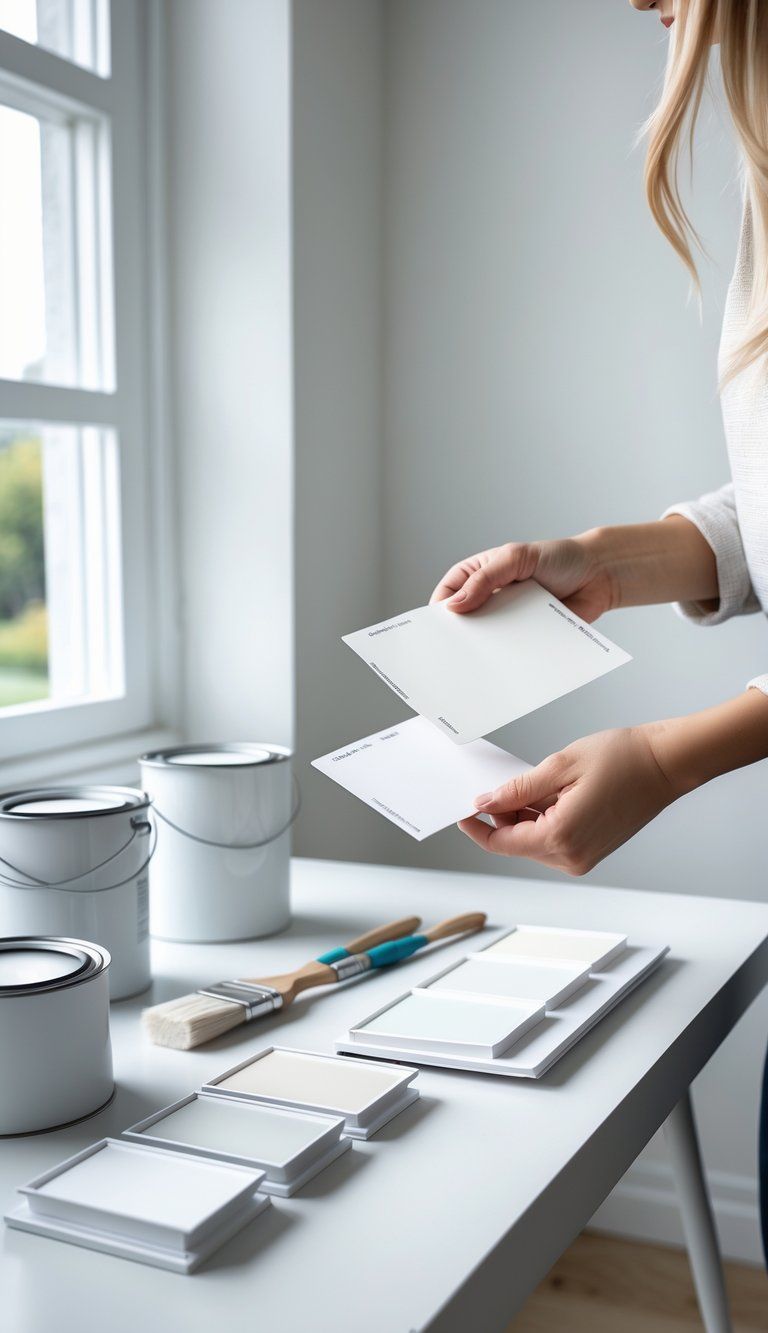
Finding the right white paint takes some trial and error. The perfect shade can totally change your space, but the wrong one might leave it feeling cold or blah.
Using Paint Samples
Start by grabbing small paint samples that match what you’re picturing. Paint stores usually sell sample pots for five to ten bucks. It’s a small price to avoid a big mistake.
Pick three to five whites with different undertones. If you want warmth, look for whites with beige, yellow, or pink hints. Cooler spaces? Try whites with blue, gray, or even purple undertones.
Paint big swatches—at least 12 by 12 inches—on different walls. Do two coats to see the real color. Label each swatch so you don’t mix them up.
Check your samples at all times of day. Morning and evening light are totally different, and artificial lights can trick your eye. Snap some photos at different times to help you compare.
Comparing Paint Swatches
Hold your swatches next to the stuff you already have—trim, furniture, flooring. See how they play together.
White paint changes based on what’s nearby:
- Dark furniture: Makes whites look brighter
- Other whites: Shows off undertones more
- North-facing rooms: Whites can look cooler or bluer
- South-facing rooms: Whites often look warmer or more yellow
Try swatches on different walls. The same white might look totally different in sunlight than in shadow.
Think about finish too. Matte hides flaws but is harder to clean. Semi-gloss bounces more light and is good for kitchens or baths.
Making the Final Decision
Go with your gut, not just the paint’s name. “Pure white” can look totally different from one brand to another.
Live with your finalists for a few days. Notice how you feel in the room. The right white should make you comfortable and happy.
Think about practical stuff too. If you’ve got kids or pets, you’ll need a finish that wipes clean. For ceilings, flat paints hide flaws best.
Ask yourself:
- Does this white feel too stark or too creamy?
- How does it look with my stuff?
- Does it set the mood I want?
Remember, your lightbulbs matter too. LEDs, incandescent, and fluorescent bulbs all change how white paint appears.
Special Considerations for White Trim
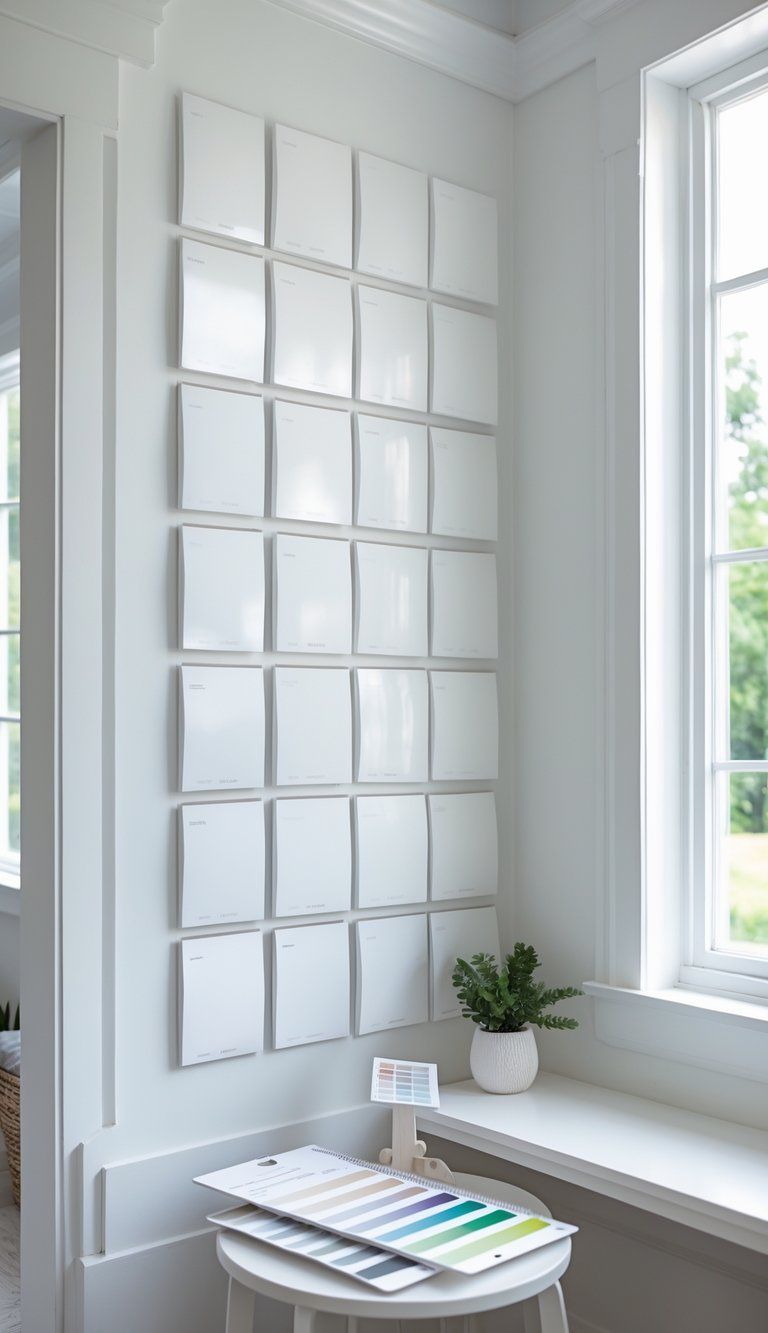
Picking the right white for trim can be trickier than it looks. Trim frames your space and really sets the tone.
Match trim to your walls: Got warm wall colors? Use a warm white trim. For cool walls, stick with a cool white trim. That way, everything feels like it belongs together.
Consider the sheen: Trim almost always looks best in satin or semi-gloss. These finishes are:
- More durable
- Easier to clean
- More reflective (so the trim pops)
Test before committing: Light can really shift how white paint looks. North-facing rooms cool things down, while south-facing rooms make whites warmer.
Pure White by Sherwin Williams is a super flexible pick. It sits right in the middle—not too warm, not too cool—so it works for trim all over the house.
Popular white trim options:
- Sherwin Williams Pure White (balanced)
- Sherwin Williams Extra White (true white, no yellow or gray)
- Benjamin Moore Atrium White (a touch of warmth)
If you’re unsure, use the same white for walls and trim but change up the sheen. Trim in semi-gloss will look a bit brighter than matte walls, giving you just enough contrast.
Always check your trim color next to your wall paint and flooring. White trim should work with everything else in the room, not fight against it.
Maintaining Your White Walls
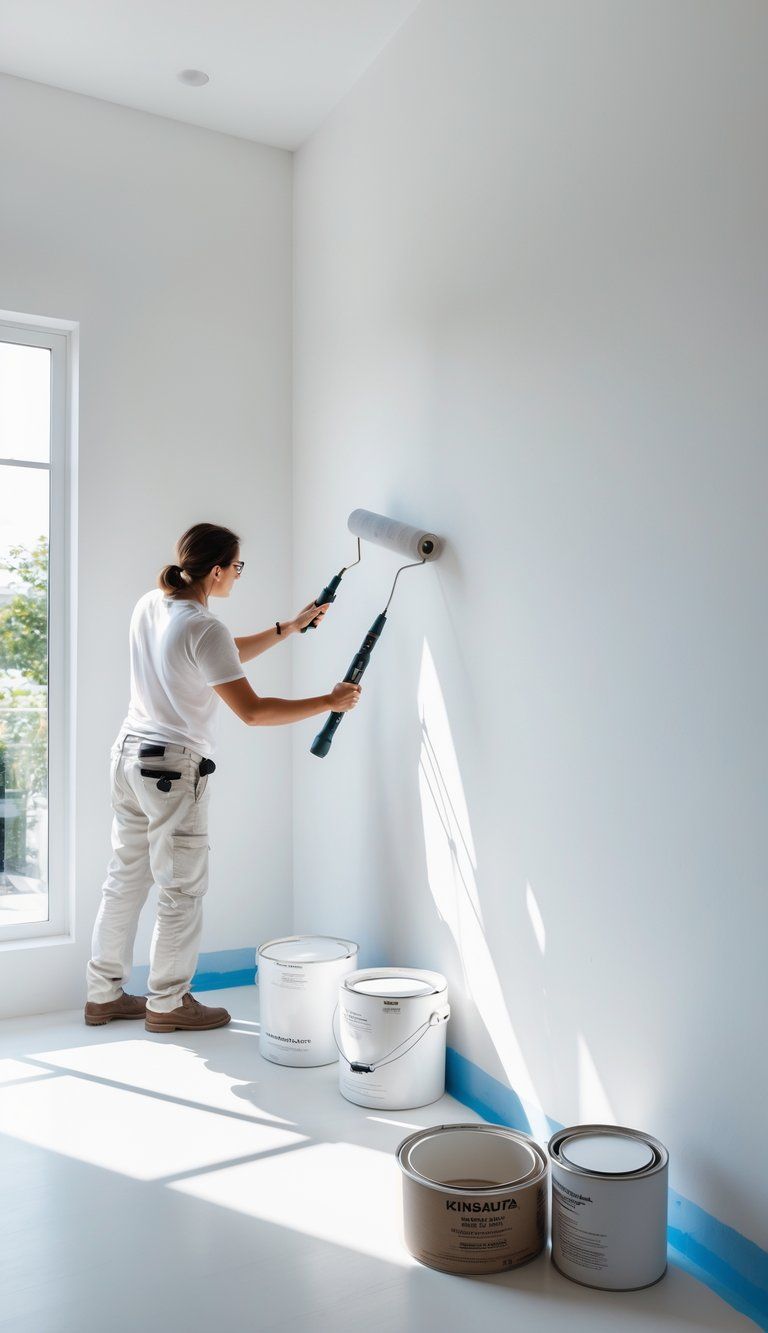
White walls really brighten up a room and make it feel clean. The downside? They show dirt and little marks way faster than darker paint.
If you want them to look fresh longer, you’ll need to give them a little extra attention.
Regular Cleaning Schedule
- Dust the walls every month or two with a microfiber cloth.
- Wipe down spots people touch a lot every week.
- Do a deep clean twice a year.
The cleaning method you choose makes a big difference. I usually grab a soft cloth, some warm water, and mild dish soap for most jobs.
Skip the harsh stuff—strong chemicals can ruin the paint finish before you know it.
Handling Stains
You’ll need to treat different stains differently:
| Stain Type | Best Cleaning Method |
|---|---|
| Fingerprints | Magic eraser (try it in a hidden spot first) |
| Scuff marks | Baking soda paste |
| Crayon | Vinegar solution |
| Grease | Dish soap and warm water |
Don’t wait around if you see a new stain. The longer it sits there, the more stubborn it gets.
Touch-Up Tips
Keep some leftover paint handy for touch-ups. It helps to label the can with the room, color, and finish so you’re not guessing later.
Before you touch up, clean the spot and let it dry all the way.
For tiny marks, I prefer using a small artist’s brush instead of a roller. That way, you don’t end up with obvious patches everywhere.
Try using furniture pads where your chairs or tables touch the wall. It’s a little thing, but it can save you from annoying scuffs and scratches.
If you stay on top of it, your white walls can keep looking crisp and clean for a long time.

